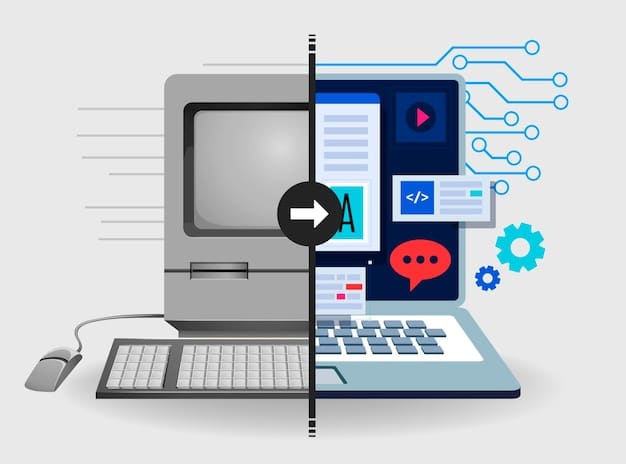Student Loan Forgiveness: Key Changes Educators Need to Know (US)

Major changes to student loan forgiveness programs are underway in the US, impacting educators significantly. This article outlines the key reforms, eligibility criteria, and how these changes can benefit educators in managing their student debt effectively.
The landscape of student loan forgiveness is shifting, and it’s crucial for educators to stay informed. Major changes to student loan forgiveness programs: What educators need to know now involves understanding new eligibility requirements, program structures, and application processes to effectively manage and potentially alleviate student debt. This article provides a comprehensive guide to help US educators navigate these changes.
Understanding the Current Student Loan Forgiveness Landscape
The current landscape of student loan forgiveness is complex, shaped by years of legislation and evolving economic conditions. Recent changes aim to simplify and expand access to these programs, but educators need to be aware of the underlying framework to take full advantage of available opportunities. These changes reflect a commitment to supporting educators and recognizing their vital role in society.
Federal Student Loan Forgiveness Programs
Federal student loan forgiveness programs provide opportunities for eligible borrowers to have a portion or all of their federal student loan debt forgiven. These programs are designed to encourage public service and provide relief to those working in specific professions.
- Teacher Loan Forgiveness (TLF): Offers forgiveness of up to $17,500 to qualified teachers who serve for five consecutive years in designated low-income schools.
- Public Service Loan Forgiveness (PSLF): Forgives the remaining balance on Direct Loans after 120 qualifying monthly payments made under a qualifying repayment plan while working full-time for a qualifying employer.
- Income-Driven Repayment (IDR) Forgiveness: Forgives the remaining balance on loans after 20 or 25 years of qualifying payments under an income-driven repayment plan.
These federal programs offer distinct benefits but also have specific eligibility requirements, making it essential for educators to understand the details of each.
In conclusion, understanding the current student loan forgiveness landscape is the first step for educators seeking relief from their student debt. By grasping the basics of these programs, educators can make informed decisions and navigate the complexities of eligibility and application processes.
Key Updates to the Public Service Loan Forgiveness (PSLF) Program
The Public Service Loan Forgiveness (PSLF) program has undergone significant updates in recent years, making it more accessible and less restrictive for public service employees, including educators. These changes aim to address past shortcomings and expand the benefits of the program to a wider range of eligible borrowers. It’s crucial for educators to understand these updates to maximize their chances of qualifying for PSLF.
Temporary Changes to PSLF
The limited PSLF waiver, which expired on October 31, 2022, allowed borrowers to receive credit for past periods of repayment that would not normally qualify for PSLF. This waiver significantly increased the number of borrowers who were able to receive forgiveness.
The Biden-Harris administration has implemented several changes to the PSLF program to make it more accessible to borrowers. These changes include:
- Allowing borrowers to receive credit for late and partial payments.
- Expanding the definition of qualifying employment to include certain types of contractors.
- Creating a simplified application process.

These temporary changes have had a substantial impact on the accessibility and effectiveness of the PSLF program.
In summary, the key updates to the PSLF program represent a significant effort to streamline and expand access to loan forgiveness for educators. By being aware of these changes and their implications, educators can better navigate the PSLF process and increase their chances of receiving loan forgiveness.
Income-Driven Repayment (IDR) Plan Adjustments
Income-Driven Repayment (IDR) plans have been adjusted to provide more affordable monthly payments and a clearer path to loan forgiveness based on income and family size. These adjustments are particularly beneficial for educators with lower incomes or larger families. Understanding these changes can help educators better manage their student loan debt.
The SAVE Plan
The Saving on A Valuable Education (SAVE) plan is the newest income-driven repayment plan, replacing the REPAYE plan. It offers the lowest monthly payments of any IDR plan and includes several additional benefits.
The SAVE Plan offers several key benefits for educators:
- Lower Monthly Payments: Payments are based on a smaller percentage of discretionary income.
- Unpaid Interest Benefit: The government covers unpaid interest, preventing loan balances from growing.
- Faster Forgiveness: The timeline to forgiveness reduced to 20 years for those with only undergraduate loans.
The SAVE Plan is designed to make loan repayment more manageable and affordable for borrowers, especially those in lower-paying public service professions.
In conclusion, the Income-Driven Repayment (IDR) plan adjustments, particularly the SAVE Plan, offer significant advantages for educators seeking to manage their student loan debt. By understanding the details of these plans, educators can make informed decisions and potentially reduce their monthly payments and accelerate their path to loan forgiveness.
Navigating the Teacher Loan Forgiveness (TLF) Program
The Teacher Loan Forgiveness (TLF) program is a targeted initiative designed to encourage qualified teachers to serve in low-income schools. Understanding the eligibility requirements, benefits, and application process is essential for educators who wish to take advantage of this program. This section provides a comprehensive guide to navigating the TLF program effectively.
Eligibility and Requirements for TLF
To be eligible for the TLF program, teachers must meet specific criteria related to their teaching service, loan types, and academic qualifications.
Key eligibility criteria for TLF include:
- Teaching Service: The teacher must have taught full-time for five consecutive academic years in a qualifying low-income school.
- Loan Type: The loans must be Direct Loans or Federal Family Education Loan (FFEL) Program loans.
- Teacher Qualification: The teacher must meet specific academic qualifications and state certification requirements.

Meeting these requirements is crucial for qualifying for TLF and receiving loan forgiveness.
In summary, navigating the Teacher Loan Forgiveness (TLF) program requires a thorough understanding of its eligibility requirements, application process, and potential benefits. By carefully following these steps, educators can increase their likelihood of qualifying for TLF and receiving valuable loan forgiveness.
How Educators Can Maximize Loan Forgiveness Opportunities
To maximize loan forgiveness opportunities, educators need to proactively manage their student loans. Careful planning, informed decision-making, and diligent adherence to program requirements can significantly increase the chances of receiving loan forgiveness. This section outlines practical strategies for educators to make the most of available loan forgiveness programs.
Steps to Maximize Loan Forgiveness
To maximize loan forgiveness, educators need to take several proactive steps:
- Understand Eligibility Requirements: Carefully review the eligibility criteria for each loan forgiveness program.
- Choose the Right Repayment Plan: Select an income-driven repayment plan that aligns with your financial situation and career goals.
- Maintain Qualifying Employment: Ensure you are working full-time for a qualifying employer under the PSLF program.
These steps provides a practical framework for educators to navigate the landscape of student loan forgiveness and increase their chances of receiving loan forgiveness.
In conclusion, maximizing loan forgiveness opportunities requires a combination of informed decision-making, strategic planning, and diligent follow-through. By proactively managing their student loans and staying informed about program changes, educators can significantly increase their chances of receiving valuable loan forgiveness.
Additional Resources and Support for Educators
Navigating the complexities of student loan forgiveness programs can be challenging, and it’s essential for educators to have access to reliable resources and support. Various organizations and platforms provide information, counseling, and tools to help educators manage their student loans effectively. These resources can empower educators to make informed decisions and take full advantage of available loan forgiveness opportunities.
Where to Find Help
Support and resources are available from the following:
- U.S. Department of Education: The official website provides detailed information about federal student loan programs, eligibility requirements, and application processes.
- Nonprofit Organizations: Many nonprofit organizations offer free or low-cost student loan counseling, including guidance on loan forgiveness programs and repayment options.
- Financial Advisors: Consulting with a financial advisor who specializes in student loan planning can provide personalized advice and support.
Accessing these resources can significantly enhance educators’ ability to navigate the complexities of student loan forgiveness and achieve their financial goals.
In summary, additional resources and support are available from a variety of sources, including government agencies, nonprofit organizations, and financial advisors. By accessing these resources, educators can enhance their understanding of student loan forgiveness programs and receive the guidance they need to make informed decisions and manage their student loans effectively.
| Key Point | Brief Description |
|---|---|
| 🔑 PSLF Updates | Easier access for public service employees. |
| 💰 SAVE Plan Benefits | Lower payments and faster forgiveness options. |
| 🍎 TLF Eligibility | Must teach in a low-income school for five years. |
| 📚 Proactive Steps | Understand requirements and choose the right plan. |
Frequently Asked Questions (FAQ)
▼
The PSLF program now has easier access and less strict rules. This means more educators can qualify, including those with late or partial payments, and contractors in some instances.
▼
The SAVE plan lowers monthly payments by basing them on a smaller percentage of discretionary income. It also covers unpaid interest, preventing loan balances from increasing over time.
▼
To be eligible for TLF, teachers must have taught full-time for five consecutive academic years in a qualifying low-income school and hold eligible Direct Loans or FFEL Program loans.
▼
Educators should understand the eligibility requirements for each program, choose the right repayment plan, and maintain qualifying employment while diligently following the application instructions.
▼
Educators can find resources from the U.S. Department of Education, nonprofit organizations, and financial advisors who specialize in student loan planning and provide tailored advice.
Conclusion
Staying informed about the major changes to student loan forgiveness programs is crucial for educators in the US. By understanding the updates to PSLF, the benefits of the SAVE plan, and the eligibility requirements for TLF, educators can proactively manage their student loans and maximize their opportunities for loan forgiveness. Accessing additional resources and support will further empower educators to navigate the complexities of student loan repayment and achieve their financial goals.





